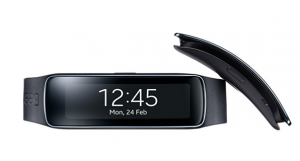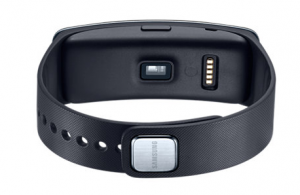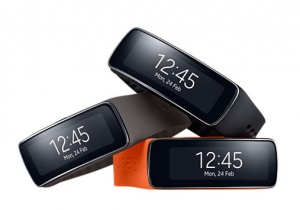The Gear Fit is Samsung’s answer to a budding world of fitness tracking gadgetry. Of course, Sammy also included an optical heart rate monitor and native health apps in the Fit’s brethren, the Gear 2. The Gear Fit is, however a full featured fitness band similar to the Fitbit.
What makes the Fit so, well… fit? It includes a bevy of health tracking hardware such as a heart rate monitor, a pedometer and more. What kinds of activities can it track? You can collect data while you’re walking, running, biking, and even sleeping. The display sure does look beautiful even if the wonky horizontal form factor is a bit of a turn-off.
How does the device fare in terms of performance and usability? Continue reading our Samsung Gear Fit review to find out.
Overview
| Samsung Gear Fit Review | |
| Overall: (3/5) | |
| Build: (3/5) | |
| Design: (5/5) | |
| Customization: (1/5) | |
| Functionality: (3/5) | |
| Compatibility: (3/5) | |
At first glance the Gear Fit is absolutely beautiful. When you jump into the UI and start poking around that appeal doesn’t disappear. Unfortunately, the device isn’t quite as glorious as it seems. It features a 1.84” curved Super AMOLED display that sometimes works in a horizontal orientation and other times works in a vertical one. Samsung devices have never really had issues when it comes to the display, and the Gear Fit is no exception. The LED shows incredibly vivid colors and sharp contours. In fact, the screen is what gives the device most of its external beauty. The biggest downfall is that it’s difficult to discern in direct sunlight. Even in the special “outdoor brightness” mode onscreen elements can be difficult to see, and it doesn’t help that the device only remains in that mode for about five minutes before reverting to default settings. Worse yet, there’s no ambient light sensor available either.
The device itself is made with a sturdy plastic, but we’ll explain more about the actual build later. It can connect to a Samsung smartphone through Bluetooth to grab notifications and similar alerts, but the Fit was mainly meant to serve as a – you guessed it – fitness band. It kind of gets the job done in that regard, albeit with some pretty serious setbacks.
- Overall: 3/5 – Samsung’s Gear Fit can double as a smartwatch, but it was meant to be a fitness band – unfortunately, it stumbles more while functioning as the latter.
Build
 The Gear Fit is made entirely of plastic. The device itself is a seamless module of sorts that can attach and detach from the wristband. The band is also interchangeable though it uses a proprietary design which means you’ll most likely need to purchase replacements and back-ups from Sammy. There are six band colors to choose from, and you can swap out the band at will. The bands are decent, but they definitely are not indestructible and neither is the Fit. The Fit has one physical button on the side that juts out slightly. You can press it once to use it as a home button, or double press to open user configurable apps. The button itself feels chintzy and will surely suffer from wear and tear after extended use – though admittedly I did not use the device long enough to find out. The bezel around the screen is chrome, but it too is plastic like the rest of the body. It’s not terribly weak so it could definitely survive a few drops, or even maybe the accidental kick while you’re scrambling to pick it back up. That being said, the Gear Fit can be broken and I’m sure it will happen to someone – unfortunate, though that may be.
The Gear Fit is made entirely of plastic. The device itself is a seamless module of sorts that can attach and detach from the wristband. The band is also interchangeable though it uses a proprietary design which means you’ll most likely need to purchase replacements and back-ups from Sammy. There are six band colors to choose from, and you can swap out the band at will. The bands are decent, but they definitely are not indestructible and neither is the Fit. The Fit has one physical button on the side that juts out slightly. You can press it once to use it as a home button, or double press to open user configurable apps. The button itself feels chintzy and will surely suffer from wear and tear after extended use – though admittedly I did not use the device long enough to find out. The bezel around the screen is chrome, but it too is plastic like the rest of the body. It’s not terribly weak so it could definitely survive a few drops, or even maybe the accidental kick while you’re scrambling to pick it back up. That being said, the Gear Fit can be broken and I’m sure it will happen to someone – unfortunate, though that may be.
- Build: 3/5 – The overall build quality is decent, but it’s hard to appreciate chintzy plastic especially when it comes to a wearable device – a lot can happen while you’re swinging your arms.
Design
If it weren’t for the plastic exterior I would say the Gear Fit has the ideal design, at least when compared to other fitness bands on the market. Make no mistake about it, if you loathe bulky wrist-worn devices you won’t feel any differently about the Fit. The seamless design and remarkably vivid display definitely propel this bad boy in the front of the competition. The bands could be a bit more attractive but they work, and the fact that there are six colors available to consumers is always a plus. You can also detach the Fit from the band completely and carry it around – it feels almost like an oversized Bluetooth headset when used in this manner. Nothing about the device is ugly, unless you completely dislike chrome bezels. Although, the bezel on the Fit is very thin. Personally, I think it adds a nice touch.
- Design: 5/5 – when compared to the competition (other fitness bands) the Gear Fit is definitely one of the most attractive options out there right now.
Customization
A device such as the Fit is always going to have a few setbacks when it comes to personalization. Luckily, you can swap out the wristband if you want, although you’ll have to purchase a proprietary replacement and only six colors are available currently. Software-wise you can’t really customize much. This is clearly the area where the Fit will be docked the most in points.
- Customization: 1/5 – you can swap out the wristband (there are six colors available currently) but it’s a proprietary design and spares will almost certainly need to be purchased from Samsung.
Functionality
 The Samsung Gear Fit is pretty crippled when it comes to functionality. This is largely due to the fact that the device is running a proprietary OS instead of Samsung’s Tizen or Android. Why Sammy decided to use a different OS for the Fit instead of the other Gear models is beyond me. This also means that the Fit cannot benefit from third party apps developed for Samsung’s other smartwatches. You’ll be confined to what’s on the device for now. It’s possible in the future Samsung will release a software update to remedy this, but that’s very unlikely.
The Samsung Gear Fit is pretty crippled when it comes to functionality. This is largely due to the fact that the device is running a proprietary OS instead of Samsung’s Tizen or Android. Why Sammy decided to use a different OS for the Fit instead of the other Gear models is beyond me. This also means that the Fit cannot benefit from third party apps developed for Samsung’s other smartwatches. You’ll be confined to what’s on the device for now. It’s possible in the future Samsung will release a software update to remedy this, but that’s very unlikely.
Once the device is turned on you’ll be presented with the home screen. The home screen can be customized a bit, but only slightly. There are ten different visual themes to choose from, and you can even set a custom wallpaper using images in your gallery. You can also choose to display one of several different functions such as the pedometer, weather, calendar appointments or various clock styles. You can have icons on screen for the different apps, three at a time or one single icon if you want them displayed larger (lots of wasted screen space). All of these customizations can be managed through the Samsung Gear Fit Manager, the companion smartphone app. There’s also a menu that can be split into two categories: one for fitness related apps, and the other for smartwatch related apps.
When it comes to the fitness tracking, the Gear Fit is a little unreliable. The pedometer is not very accurate, and it doesn’t sync properly with the S Health app. If you want to use two functions simultaneously such as the heart rate monitor and the pedometer you have to activate each separately – which can be a pain when you’re trying to get in a quick workout. You also have to reset the pedometer’s step count every time you want to use it, so if you are relying on it to calculate your daily travel you’ll need to start over for your workout. The sleep tracker is pretty much useless, because it takes advantage of the devices accelerometer to track your movement which doesn’t always work especially if you’re a light sleeper. It also requires manual input from the user before they actually fall asleep, which means the device is really tracking how long you spend lying in bed. Most of this stuff may or may not be solved through system updates, but currently the Gear Fit is not as reliable as it should be in terms of fitness tracking.
As for smartwatch functionality the Gear Fit doesn’t offer much. You can receive notifications similar to the Pebble or other Gear smartwatches. The display layout makes them appear a bit odd, and glancing at the screen in a vertical fashion can be a bit dizzying. The device awkwardly displays message data in a vertical list which can make for some confusing alerts. Of course, the Fit also has a stopwatch and media controller which can both be quite useful. It’s worth mentioning that there is a “do not disturb” mode which turns off all notifications and vibrations. However, the mode is only available while you’re sleeping, or more specifically while the sleep tracker is active.
The Galaxy Gear Fit battery lasts about three to four days. That battery life is retained even when connected to a smartphone the entire time, which is refreshing. Although, I’m not a big fitness buff in that I don’t run or exercise daily. I’m sure the battery results will vary depending on how much you use the Fit, as is to be expected.
- Functionality: 3/5 – the fitness tracking functionality is a bit limited and some of the collected data can be inaccurate, as for the smartwatch stuff the Fit is also limited in that regard too.
Compatibility
As with the other Samsung Gear devices, this is where the Fit is going to take a pretty big hit. For some reason, Samsung doesn’t see anything wrong with limiting their smartwatches to Samsung-only handsets. That means if you have another type of Android device or even an iPhone, the Gear Fit will be useless to you. It doesn’t help that the device is priced at $199, putting it at the higher end of the market. Most would be better suited picking up the Fitbit Flex for $100, which is a lot less limited and quite a bit more accurate for fitness tracking.
- Compatibility: 3/5 – the Gear Fit is only compatible with Samsung branded handsets
Conclusion
 It’s a shame really, because the Gear Fit has a lot of potential. The device itself is fairly attractive especially when compared to other fitness bands currently on the market. The display is also beautiful, and the design is unique. Unfortunately, Samsung just didn’t make good use of the Fit in terms of functionality. They chose a proprietary OS instead of Tizen – like the Gear 2 – and that means limited app support. Additionally, the hardware is unreliable – the pedometer seems to be off quite a bit and the sleep tracker is pretty much useless. There’s really only one smartwatch feature which is the notification support and the odd horizontal and vertical screen angles make reading alerts unpleasant.
It’s a shame really, because the Gear Fit has a lot of potential. The device itself is fairly attractive especially when compared to other fitness bands currently on the market. The display is also beautiful, and the design is unique. Unfortunately, Samsung just didn’t make good use of the Fit in terms of functionality. They chose a proprietary OS instead of Tizen – like the Gear 2 – and that means limited app support. Additionally, the hardware is unreliable – the pedometer seems to be off quite a bit and the sleep tracker is pretty much useless. There’s really only one smartwatch feature which is the notification support and the odd horizontal and vertical screen angles make reading alerts unpleasant.
To top it all off, Samsung wants you to hand over $200 for the device which is pricy especially considering there are a lot of other great devices on the market already like the FitBit Flex, Jawbone Up24 and Polar Loop. Long story short, you would be better off purchasing an alternate fitness band or smartwatch.
We hope you enjoyed our Samsung Gear Fit review and that it proved useful in your search for the perfect smartwatch. Stay tuned for our coverage of the Samsung Gear lineup!
